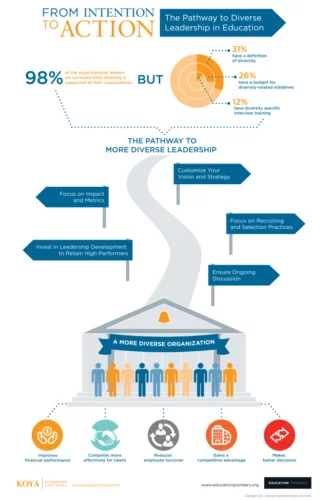Building a Diverse Team
How to Show Up
- Promote radical imagination. Encourage employees and leadership to pitch bold ideas to enact change.
- Understand your referral and recruitment pipeline. This will inform strategies on recruiting, referrals and internal mobility.
- Train your managers. Many daily interactions happen at a team level, so you must train managers on how to manage across lines of difference.
- Getting Started
More Resources
Leadership
As you take a harder look at your organization’s leadership, make sure you fully understand the path to leadership at your organization and where your diverse leaders come from. Assess how accountable your leadership team is to your DEI initiatives. Finally, ensure access to leadership is equitable and clearly communicated to staff and others within your organization.
Pipeline
Consider your leadership team’s overall diversity. Are there patterns in how your current leaders came into their current roles? Were they promoted from within or were they outside hires? A better understanding of your leadership pipeline and current barriers to leadership opportunities will inform strategies for either focusing in on existing recruitment sources, diversifying your sources or placing greater emphasis on developing more diverse leaders from within.
Development
If you seek to develop more diverse leaders from within and promote current managers to leadership, your organization should be as transparent as possible about leadership criteria and responsibilities. Draw a line between where management roles end and leadership begins, and make this line clear to your team. Special consideration should also be given to who has access to leadership development opportunities and what opportunities exist for visibility to current organizational leaders. Doing so can help level the playing field for aspiring leaders and create objective benchmarks to achieve as diverse staff work toward leadership roles.
Accessibility
Do team members have the ability to talk to leaders, and do leaders even have time to spend with their teams? Is there a divide between which team members have access to leaders, and is there clarity around how a team member gets access to a leader? To achieve true DEI and equal opportunities for all staff, your leadership team should not be elusive, but inclusive and accessible.
Accountability
Is your current leadership team accountable around DEI and participating in conversations about moving DEI initiatives forward? Without support and enthusiasm from your organization’s leadership, your nonprofit’s DEI goals cannot be achieved.
Talent processes and infrastructure
Thinking beyond leadership and toward your team as a whole, consider your talent processes and infrastructure and their relationship to overall culture. Assess specific activities and their potential to positively or negatively affect achieving DEI at each phase of the employment cycle: attracting, developing, engaging and rewarding your staff.
Outreach and Recruiting
How does your organization typically recruit new staff and management? Maintaining focus on too few networks and sources can be a serious hindrance to achieving diversity goals. Cast a wide net for talent and be open to candidates with “nontraditional” backgrounds as you seek to intentionally diversify your workforce. As part of this effort, it’s also critically important to help selection committees and staff involved in the recruitment process to be aware of and to work to reverse their own individual biases through training.



